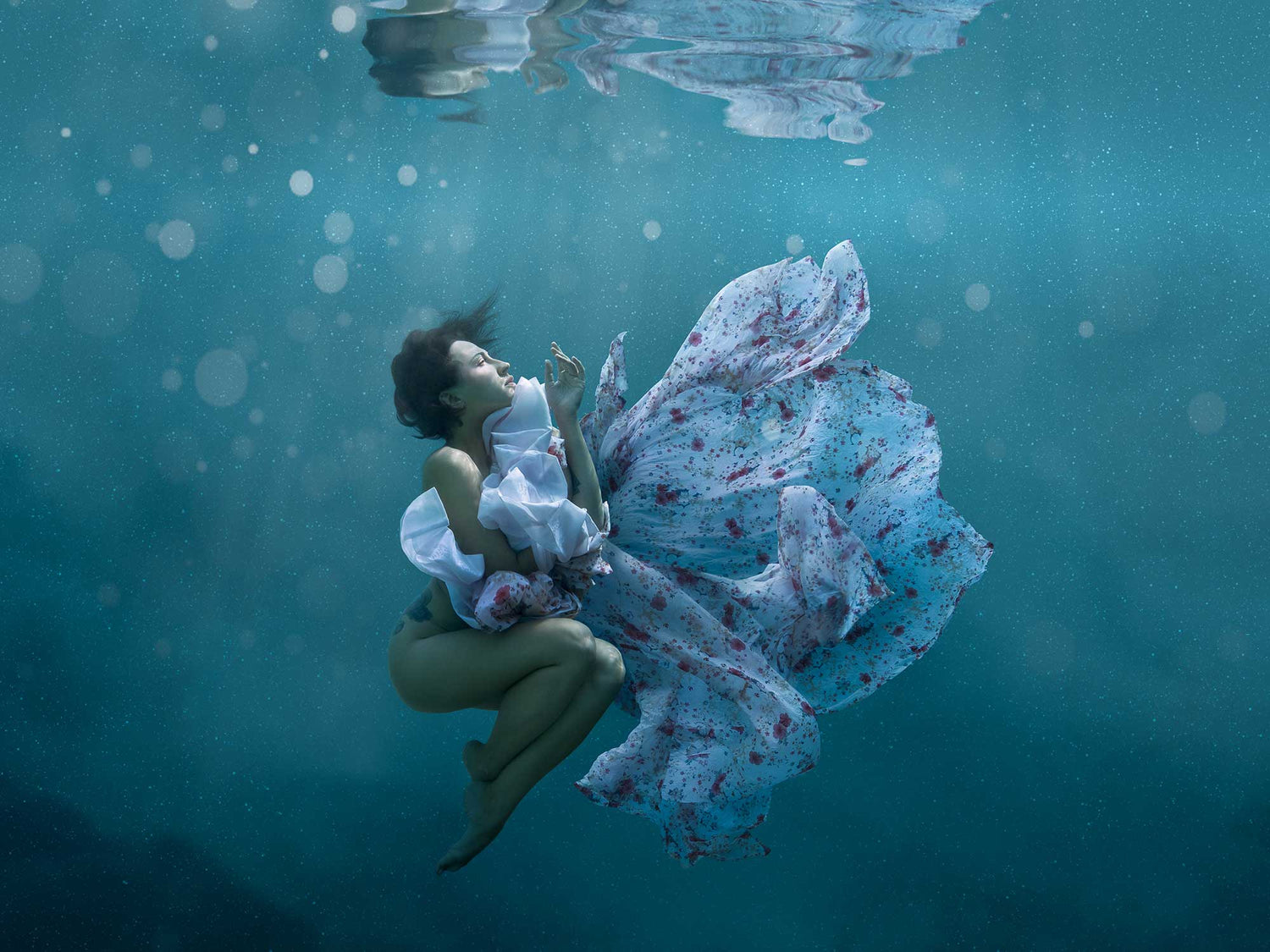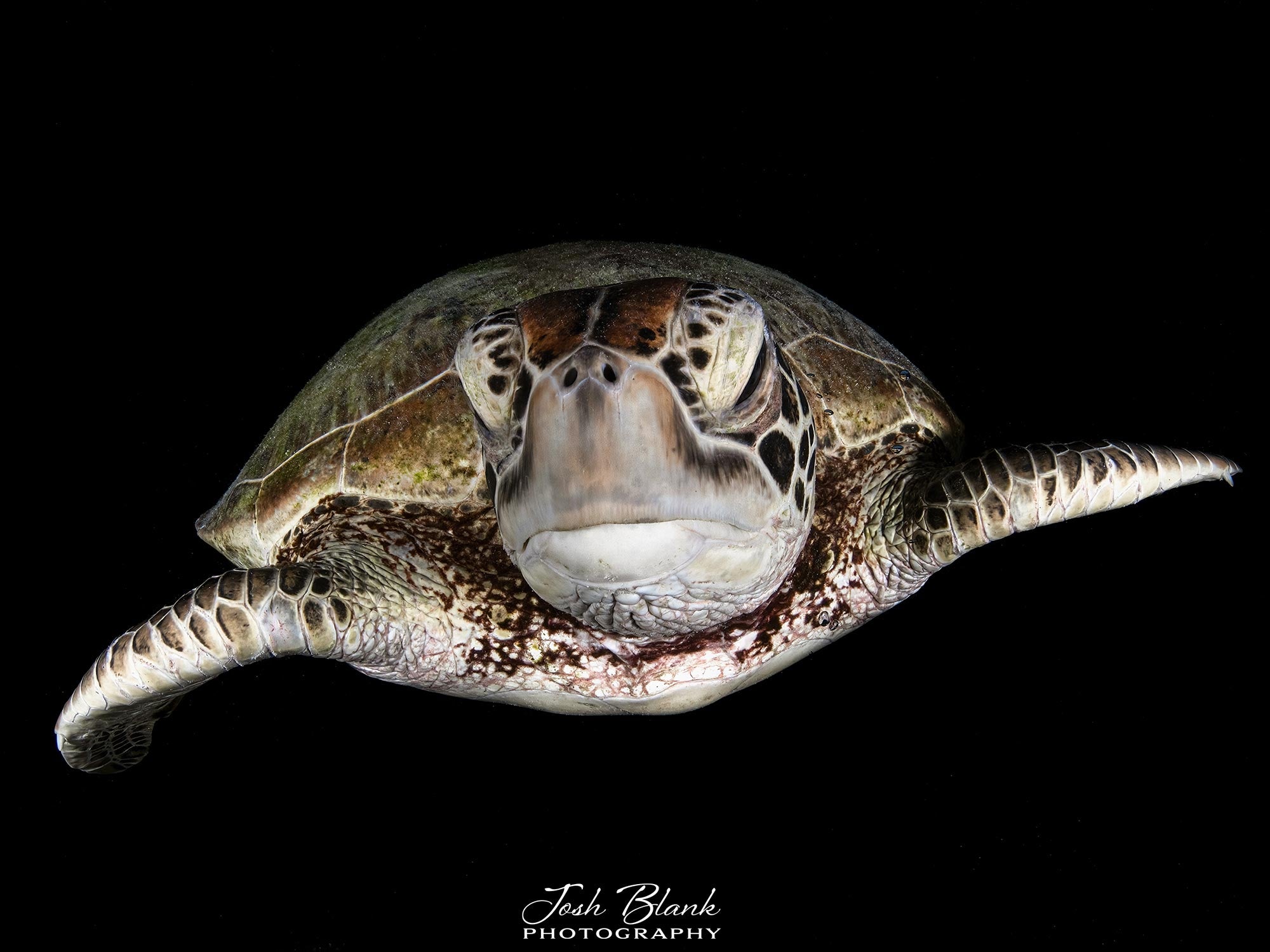By Charlotte Bories
Although I'm both certified in scuba diving and freediving, I always choose to freedive when it comes to shooting a model during a fine art session.
I have to confess that I did my first pool photoshoots freediving for the sake of convenience, but I quickly enjoyed the relationship that is established between my model and I: we are working on an equal basis, with almost similar sensations. In a way, we are in the same boat! Moreover the communication between us is clearly simpler: unlike a scuba diving shooting, we can easily debrief after each short immersion.
After a while, I felt the need to go further in my knowledge of freediving, out of personal curiosity but also, and especially, to be able to provide better support to my models. Throughout my freediving course and dives, I've greatly improved my understanding of the body's mechanisms (both physical and psychological) and I use this expertise all the time, even when I'm shooting a model in a pool.

Taking freediving classes has been a great personal enrichment, even though I shoot in pools more than half the time. © 2022 Charlotte Bories
First, A Bit of Psychology
Our preconceptions about ourselves are our worst enemies
To be honest, I started my freediving course with a bunch of a priori in mind about my abilities. “I'm an artist, not a sportwoman, for sure I will be terrible...As a scuba diver, I know perfectly how to equalize my ears...I won't be able to go down in the deep along the rope, because I'm afraid of going towards the darkness...” Well, I was all wrong.
As the sessions go on, I found out that I was able to dive in the ocean, towards the depths, without any apprehensions (the pre-dive relaxation probably helped a lot), that my static apnea could reach 4.30 minutes (I was shocked!), and that, eventually, the main obstacle I'd have to overcome was... my stupid left ear! This tiny tube was stubbornly reluctant to equalize when I was diving head down, whereas it had absolutely no problem when I was scuba diving.
All this doesn't look like much, but it opened my eyes on the fact that we all come to new experiences with preconceived ideas about ourselves, and, most of the time, we have to dismantle all these a priori to be able to go on.
I see pretty much the same thing during my fine art photoshoots: the models all come with preconceptions about their abilities. Most of the time, they are not sure they can do it. They think, “I can't stay underwater for long...I can't open my eyes” etc. This slight lack of confidence can easily be overcome by accompanying the model step by step, with kindness. Do not rush to your camera; offer your models to practice short exercises of breathing, buoyancy, etc., so that they feel they can do it. Always keep in mind that it's probably their first experience.
Some, on the contrary, are overconfident. It's rare, but it can happen. They think “I'm a model, I know exactly how to pose” or “I'm a freediver, I know exactly how to hold my breath” without realizing that an underwater photoshoot is something different from what they used to do. It's a bit more tricky to guide them, as they aren't waiting for any advice from you, but luckily there aren't too many of them.
In either case, it's important to get the model — with gentleness and tact — to deconstruct those preconceived schemes, if we want to create great pictures.

Feeling her loving and supporting husband on her side definitely helped this bride to overcome her preconceptions about what she was able to do. © 2022 Charlotte Bories
Safety First
One of the very first things we learn during a freediving course is how our body deals with the decrease of oxygen and the increase of carbon dioxide, and what the warning signs are of a fainting or other issues.
Of course, there's a huge difference between sporty freediving training and an underwater photoshoot, especially in a pool, but the risks shouldn't be minimized. During a photoshoot, the model will be required to do a very large number of apneas (a temporary cessation of breath), sometimes over several hours. It's this accumulation of short breath-holds (sometimes even with empty lungs) that can be risky.
So, it's super important to explain very clearly to the models that they shouldn't seek to challenge themselves by pushing their apnea capacity to its maximum. All along the session, remind them to resurface before they feel uncomfortable, to re-oxygenate well between each immersion, and to communicate freely with you about their fatigue and body cooling. Drinking a lot of water is also a good advice, as well as taking a big rest after the session.
Be especially vigilant with pregnant women and people over 50 (without freaking them out, though) as they can be even more sensitive to the lack of oxygenation.

For safety reasons, I always do the maternity photoshoots in shallow pools so that my model doesn’t get too tired and can surface anytime to breathe. When I want to give a spatial feel around the subject, then I just erase the floor in post-production. © 2022 Charlotte Bories
Buoyancy
When you practice apnea, you quickly realize how much the ability of managing your buoyancy is a key factor for a successful free dive. If you struggle to go down, you will spend a lot of energy — in other words, a lot of oxygen — and your dive will be drastically shortened. Various things are involved in the control of your buoyancy: the amount of air in your lungs, your body composition, the water salinity, the depth you are at.
During an apnea photoshoot, the novice models often have difficulties staying underwater, without coming up like a cork. It's related to the fact that the underwater photoshoots often takes place in very shallow water, and also that's because the models tend — by reflex — to take a very deep breath before diving. That's why I always plan a time of adjustment for my models at the beginning of each session. I watch how they move underwater and I encourage them to watch themselves, to feel how different full-lungs-dives and empty-lungs-dives are, a static pose and a pose in movement.
In some cases weights can be useful, but they should be used very carefully, because they should never interfere with the models' ability to easily catch their breath.

Mermaid tails are quite trendy these days, but they can be heavy and difficult to swim with. In case you’re planning a mermaid photoshoot in a deep pool, ensure your model is certified, and work with a safety diver on your side. © 2022 Charlotte Bories
Relaxation
Do you remember the scene from The Big Blue where Jacques Mayol seems a little high, in a meditative state, just before a free dive? Well, it's far from being anecdotal: in apnea, relaxation is key. Yoga and meditation are commonly used by freedivers, as it induces — among other benefits — a state of deep calm allowing them to minimize their oxygen expenditures, so they can hold their breath longer.
During a photoshoot, the model's relaxation is just as important, although the ultimate goal isn't staying as long as possible under the water. Many people are a bit stressed on the shooting day, because they think their apnea won't be long enough. So it's absolutely essential to make them feel comfortable, explaining that — in order to create beautiful pictures — their ability to relax is much more important than the duration of their immersion. Calm and confident models will manage their buoyancy with greater ease, their poses will be more graceful, and their face much more beautiful.
A few ideas to help your model to relax
- Ensure they are perfectly comfortable under the water (if they still have some discomfort, help them with tips or accessories).
- Take a few minutes at the beginning of the session to breathe calmly with your model. You can do it again right before shooting a close-up portrait, if necessary.
- Be calm and relaxed yourself: never underestimate the power of mimicry.

In order to take a beautiful underwater portrait, it’s absolutely essential to ensure your model is super relaxed. © 2022 Charlotte Bories
Visualization
One of the most powerful tools I discovered during my freediving course is the visualization. This technique is widely used in the sport world in order to increase the chances of success. Basically, it's about mentally picturing the action you want to do — as precisely as possible — and imagining that this action unfolds in an absolute perfect way. According to the studies conducted on the subject, it seems that an imagined experience is stored by the brain in the same way/place as a real-life experience. Simply imagining ourselves doing something activates the same neural circuitry as if we really were doing it. The more this neural circuitry is activated and solicited, the stronger it becomes. First the land is cleared, then a path is emerging, then a road is marked out. And when we find ourselves in the situation again, in real life, our brain sends to our body some signals and reflexes that are equivalent to "I already did it so I know I can do it again." I find this technique all the more fascinating that it can be used in all kinds of situations, including in a professional environment or for personal development.
I also use it sometimes for my photoshoots, even if of course we just skim the exercise. I regularly encourage my models to take the time to visualize the pose before they dive. And not only the pose, by the way: also the movements they will do to reach this pose. Usually it works quite well and it makes the models' immersions smoother, because instead of focusing on the pose and struggling to reach it, they have in mind a sequence of movements. Even before they dive, they know what they are going to do.

Even when we have a specific pose in mind, I always say to my models that something beautiful and unexpected can arise before and after the pose. That’s why I encourage them to visualize and embody a character from the beginning of the immersion until the end. © 2022 Charlotte Bories

Charlotte Bories is an award-winning French underwater photographer specializing in fine art, fashion, and fantasy images. She currently resides in Bali where she harnesses the water as a powerful medium for her storytelling. A fierce freediver and scuba diver, Charlotte mixes her underwater photography with digital media to create her dreamy underwater aesthetic. Read more...
Want the easy way to improve your underwater photography? Sign up for our weekly newsletter for articles and videos directly in your inbox every Friday:
Additional Reading
Behind the Scenes of a Short Film About Freediving
5 Tips to Improve Your Underwater Portrait Pool Photography
Getting into the Underwater Photography Business with Karen Bagley
Freediving with Orcas in Norway
Beyond the Lens with Underwater Surrealist Conor Culver













![Canon R5 Underwater A-Z // Top 3 Custom Settings for Underwater Use [VIDEO]](http://www.ikelite.com/cdn/shop/articles/Canon_R5_Settings_v2_web-1.jpg?v=1662936180&width=2400)